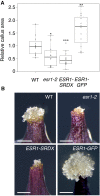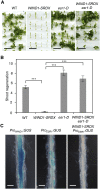WIND1 Promotes Shoot Regeneration through Transcriptional Activation of ENHANCER OF SHOOT REGENERATION1 in Arabidopsis
- PMID: 28011694
- PMCID: PMC5304349
- DOI: 10.1105/tpc.16.00623
WIND1 Promotes Shoot Regeneration through Transcriptional Activation of ENHANCER OF SHOOT REGENERATION1 in Arabidopsis
Abstract
Many plant species display remarkable developmental plasticity and regenerate new organs after injury. Local signals produced by wounding are thought to trigger organ regeneration but molecular mechanisms underlying this control remain largely unknown. We previously identified an AP2/ERF transcription factor WOUND INDUCED DEDIFFERENTIATION1 (WIND1) as a central regulator of wound-induced cellular reprogramming in plants. In this study, we demonstrate that WIND1 promotes callus formation and shoot regeneration by upregulating the expression of the ENHANCER OF SHOOT REGENERATION1 (ESR1) gene, which encodes another AP2/ERF transcription factor in Arabidopsis thaliana The esr1 mutants are defective in callus formation and shoot regeneration; conversely, its overexpression promotes both of these processes, indicating that ESR1 functions as a critical driver of cellular reprogramming. Our data show that WIND1 directly binds the vascular system-specific and wound-responsive cis-element-like motifs within the ESR1 promoter and activates its expression. The expression of ESR1 is strongly reduced in WIND1-SRDX dominant repressors, and ectopic overexpression of ESR1 bypasses defects in callus formation and shoot regeneration in WIND1-SRDX plants, supporting the notion that ESR1 acts downstream of WIND1. Together, our findings uncover a key molecular pathway that links wound signaling to shoot regeneration in plants.
© 2016 American Society of Plant Biologists. All rights reserved.
Figures









Similar articles
-
WIND1 induces dynamic metabolomic reprogramming during regeneration in Brassica napus.Dev Biol. 2018 Oct 1;442(1):40-52. doi: 10.1016/j.ydbio.2018.07.006. Epub 2018 Jul 17. Dev Biol. 2018. PMID: 30026120
-
WIND1-based acquisition of regeneration competency in Arabidopsis and rapeseed.J Plant Res. 2015 May;128(3):389-97. doi: 10.1007/s10265-015-0714-y. Epub 2015 Mar 26. J Plant Res. 2015. PMID: 25810222
-
Overexpression of Arabidopsis ESR1 induces initiation of shoot regeneration.Plant Cell. 2001 Dec;13(12):2609-18. doi: 10.1105/tpc.010234. Plant Cell. 2001. PMID: 11752375 Free PMC article.
-
How do plants transduce wound signals to induce tissue repair and organ regeneration?Curr Opin Plant Biol. 2020 Oct;57:72-77. doi: 10.1016/j.pbi.2020.06.007. Epub 2020 Jul 29. Curr Opin Plant Biol. 2020. PMID: 32738736 Review.
-
Signaling in shoot and flower meristems of Arabidopsis thaliana.Curr Opin Plant Biol. 2014 Feb;17:96-102. doi: 10.1016/j.pbi.2013.11.011. Epub 2013 Dec 13. Curr Opin Plant Biol. 2014. PMID: 24507500 Review.
Cited by
-
Cytokinin Signaling and De Novo Shoot Organogenesis.Genes (Basel). 2021 Feb 12;12(2):265. doi: 10.3390/genes12020265. Genes (Basel). 2021. PMID: 33673064 Free PMC article. Review.
-
Genome-Wide Identification and Analysis of the APETALA2 (AP2) Transcription Factor in Dendrobium officinale.Int J Mol Sci. 2021 May 14;22(10):5221. doi: 10.3390/ijms22105221. Int J Mol Sci. 2021. PMID: 34069261 Free PMC article.
-
An inducible CRISPR activation tool for accelerating plant regeneration.Plant Commun. 2024 May 13;5(5):100823. doi: 10.1016/j.xplc.2024.100823. Epub 2024 Jan 18. Plant Commun. 2024. PMID: 38243597 Free PMC article.
-
REGENOMICS: A web-based application for plant REGENeration-associated transcriptOMICS analyses.Comput Struct Biotechnol J. 2022 Jun 16;20:3234-3247. doi: 10.1016/j.csbj.2022.06.033. eCollection 2022. Comput Struct Biotechnol J. 2022. PMID: 35832616 Free PMC article.
-
Transcriptome analysis reveals the regulatory mechanism by which MdWOX11 suppresses adventitious shoot formation in apple.Hortic Res. 2022 Apr 11;9:uhac080. doi: 10.1093/hr/uhac080. eCollection 2022. Hortic Res. 2022. PMID: 35669707 Free PMC article.
References
-
- Aida M., Ishida T., Tasaka M. (1999). Shoot apical meristem and cotyledon formation during Arabidopsis embryogenesis: interaction among the CUP-SHAPED COTYLEDON and SHOOT MERISTEMLESS genes. Development 126: 1563–1570. - PubMed
-
- Aida M., Beis D., Heidstra R., Willemsen V., Blilou I., Galinha C., Nussaume L., Noh Y.S., Amasino R., Scheres B. (2004). The PLETHORA genes mediate patterning of the Arabidopsis root stem cell niche. Cell 119: 109–120. - PubMed
-
- Atta R., Laurens L., Boucheron-Dubuisson E., Guivarc’h A., Carnero E., Giraudat-Pautot V., Rech P., Chriqui D. (2009). Pluripotency of Arabidopsis xylem pericycle underlies shoot regeneration from root and hypocotyl explants grown in vitro. Plant J. 57: 626–644. - PubMed
Publication types
MeSH terms
Substances
LinkOut - more resources
Full Text Sources
Other Literature Sources
Molecular Biology Databases
Research Materials
Miscellaneous

